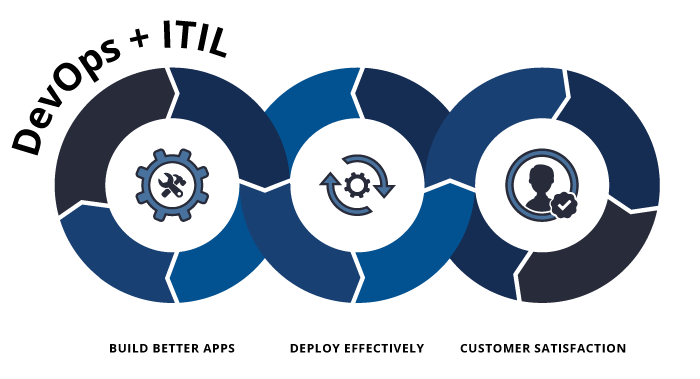Ever wondered how to Integrate DevOps to ITIL. Well, don’t wonder anymore here are some directions on how to Integrate DevOps to ITIL.
Among the many miracles of DevOps culture and practices is that several elements of ITIL processes can be easily automated. It solves substantial challenges, especially in the launch, configuration, as well as in deployment.
As an example, a deployment pipeline regularly fully automates our installation and launch measures. And infrastructure management tools like; Consul and Zookeeper make service discovery and dependency mapping (the traditional domain of configuration management). Just one more part of every development team’s daily work. If programmers do not get it right, their service won’t operate, won’t understand how to connect to other services, etc.
Also, DevOps requires rapid detection and retrieval when Service incidents occur. The ITIL areas of the event, incident, and problem management remain as relevant as ever. Along with that automation continually frees more time to focus on value-adding service improvements.
Collaboration is needed to Integrate DevOps to ITIL?
But if we need DevOps to be widely adopted in large, complex Associations. The DevOps community must earn the confidence of ITSM professionals. And see how our efforts can help resolve some of their most basic and chronic challenges. The same challenges that many from the ITIL community have been trying to resolve for over two decades.
On DevOps Enterprise Summit that took place in London on 30 June and July 1, 2016. Kaimar Karu from AXELOS, the custodians of ITIL, hosted an Open Space session. Teaching how to bridge the gap between DevOps and ITIL processes and practices which are found in almost every enterprise. He taught what we should say when we hear a change manager say, “we do DevOps over my dead body,” or when a service manager says, “this will never work here.”
Kaimar explained what has changed in ITIL in the last 10 years. Covering the entire Continual Service Improvement powered service lifecycle from Design and strategy through to Transition and Operation. He also discussed the Philosophy behind the newly released ITIL Practitioner advice, designed by A global group of industry heavyweights. Including our very own Kevin Behr, to assist IT Professionals to get the customer back to the center of what they do. And He Described the magic words which we can use to construct a mutually collaborative Relationship; that helps our organizations win in the market.
Taking out the Gaps
Like DevOps, ITIL is also very keen on using “models,” and the application of service automation to increase; efficiency, speed execution, and lower costs. What ITIL emphasizes, however, is that to be successful, an IT service provider must first be strategy-driven, and procedure. Before it can realize the maximum benefits of automation. The standard change, or launch “version,” must first be recorded and analyzed. The “gaps” must be taken out, and the process and interfaces must be streamlined and automated. Only then will maximize benefits and throughput be achieved.
Application management personnel (being responsible for the whole lifecycle of applications–not just those developed in-house), should be engaged very early in the life span of service. In fact, they need to be the ones to work with the business, the individual assigned as the business relationship manager (BRM), and the service owner to identify, define, and document the complete “service solution” requirements, and ensure these are recorded in the service charter for the new or altered service being considered. According to ITIL, application management teams must work closely with development groups, who stay focused during service design and support transition on rapid development and deployment of applications that are part of the entire service solution.
While development focuses on development activities across service design and service transition, application management manages the program across the whole service lifecycle, from strategy, through transition and design (working with development), and on into operation and continual improvement. This approach guarantees that the service alternative (which comprises the program ), not only launches well but continues to perform during live operations, meeting the requirements of business clients and users.
Integrate DevOps to ITIL – Conclusion
The importance of establishing and implementing effective cross-functional communications, along with automated support systems, is also underscored by ITIL. All the various stakeholders, from front-line support desk staff and technical and application support specialists, to programmers and customers, must be linked through well-planned and efficient communications channels so that escalations can be handled quickly, and the IT support organization can truly achieve optimum flexibility and responsiveness.

